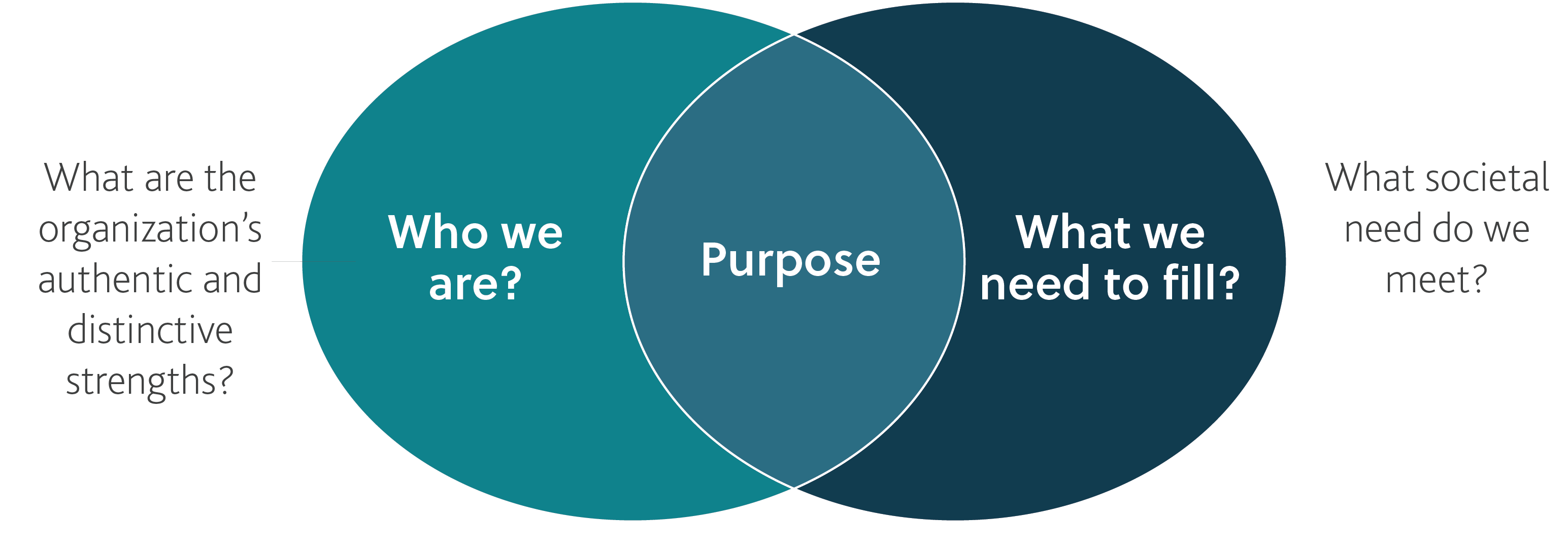Contents
- The Board imperative: Purpose-Driven Leadership
- Purpose starts at the top
- What is purpose, and why is it important
- what is purpose driven leadership
- What should boards do to ensure that their organizations' purpose is making a difference
Top
The Board imperative: Purpose-Driven Leadership
One of the quickest ways an organization can lose the trust of its key stakeholders — particularly customers, investors, and employees — is to say one thing and then do another. This gap between words and actions is often laid bare when you look closely at a company’s purpose statement.
Think about this statement from Boeing:
“Our purpose and mission is to connect, protect, explore and inspire the world through aerospace innovation. We aspire to be the best in aerospace and an enduring global industrial champion.”
Somehow, the “protect” part of their purpose was lost. Much has been written about the lax production standards that were pervasive in their rapidly constructed plants in the US Southeast, along with the FAA approval of Boeing's request to remove references to a new Maneuvering Characteristics Augmentation System (MCAS) from the flight manual.
Or this case regarding Nike:
In February 2020 the Washington Post reported that a large Nike supplier factory, Qingdao Taekwang Shoes Co., had been employing Uighurs from the Xinjiang region of China. The article referenced a report which said Uighurs in the Taekwang factory were working “under conditions that strongly suggest forced labor”.
What is their purpose?
“… to expand human potential. We do that by creating ground-breaking sport innovations, by making our products more sustainably, by building a creative and diverse global team and by making a positive impact in communities where we live and work.”
Top
Purpose starts at the top
While these two companies most likely had the right ambitions when they first conceived of their purpose and put it in writing, somewhere along the way their staff compromised on what was most important. Company boards are increasingly aware they have a clear oversight responsibility to ensure this doesn’t happen, and that their organizations are truly purpose driven.
But what does that mean in practice?
This paper aims to provide you with a pragmatic approach to support your organizations’ work to define purpose in a way that will benefit the organization and its stakeholders now and tomorrow. We will define purpose – and describe why it’s critical – and then delve into what it means to put purpose-driven board leadership in place: to ensure that purpose is being lived everyday in the organization on whose board you serve.
Top
What is purpose, and why is it important?
Purpose speaks to the unique value your organization can bring to the world. We hear descriptions such as “a company’s philosophical heartbeat,” or “describing what the organization is doing of value for someone else.”
"Purpose defines a company’s timeless character. It’s the glue that holds the enterprise together even when everything else is up for grabs… a consistent identity that transcends product or market life cycles, technological breakthroughs, management fads, and individual leaders.”
Jim Collins & Jerry Porras
In all cases, the statement of purpose is meant to inspire one’s staff — at all levels — to do great work and feel great about working where they do.
Using this mindset, one of our clients articulated a statement of purpose that went from being the product of a government agency to one that truly resonated with all their internal staff and stakeholders. Another went from a one-liner that made no mention of their own capabilities to one that reflected the powerful discovery that is the engine of their business.
| From |
To |
|---|---|
| “We will work closely with the provincial government and its partners across the province, to help investors capitalize on local investment opportunities.” |
“To retain the province’s position as one of the most attractive investment destinations in the world, we leverage deep industry knowledge and an international network to bring our province to the global stage. We build relationships to connect investors with local investment opportunities in ways that are profitable and provide sustainable, high quality jobs.” |
| “To serve as the global steward of anti-microbial technology” |
“To improve Human and Animal welfare through the ongoing research and development of our innovative solutions to anti-microbial resistance” |
And why is purpose important? Put most simply, it is the most important factor in motivating leaders, employees at all levels, and customers.
A recent McKinsey survey of over 1,200 managers and front-line employees reported 82 percent believed it was important that their company have a purpose, and 62 percent said their company had a purpose statement, but only 42 percent said their organizations’ purpose statements were having any impact.
While many organizations have a stated and formalized purpose, not all are effective. Some are so generic or aspirational as to be meaningless. For example:
A prominent European-based nutrition company has the following purpose statement:
“The company is committed to “promoting sustainable agriculture, encouraging the circular economy, conserving water, reducing waste, reducing its carbon footprint, promoting animal welfare, and investing in the community.”
Being committed to all these things is nice, but what is their product? How does their business do anything about any of these laudable goals?
A multinational telecoms company’s purpose statement is:
“We aim to build a connected society that enhances socio-economic progress, embraces everyone and does not come at the cost of our planet. That is why we have committed to improve 1 billion lives and halve our environmental impact by 2025 by taking concrete action in three areas: Digital Society, Inclusion for All, and Planet.”
Again, nothing specific in this statement points to how this company’s business outputs actually contribute to these ideals.
The active words in these statements are vague: commit, aim, and strive. And the promises are disconnected from the products and services the companies offer.
So, what are the elements of a strong purpose statement?
- It explains why your organization exists – i.e., what value you bring to customers or society
- It addresses how business is carried out – i.e., the culture of the organization, the values that are espoused, the ways customers or staff are treated
- It paints a picture of what the organization wants to be in the future – i.e., the performance goals of the organization
Let’s consider a few other, more effective, purpose statements.
Hydro-Quebec’s purpose is:
“To deliver reliable electric power and high-quality services.
By developing clean, renewable energy sources, we make a strong contribution to Quebec’s collective wealth and play a central role in the emergence of a low-carbon economy.
As recognized leaders in hydropower and large transmission systems, we export clean, renewable power and leverage our expertise and innovations within Quebec and around the world.”
This statement explains why the company exists, what it does particularly well (manage massive hydropower and large transmission systems), and how it will make a difference going forward.
IKEA’s purpose statement is also particularly strong:
It promises to “offer a wide range of well-designed, functional home furnishing products at prices so low that as many people as possible will be able to afford them.”
As a recent Harvard Business Review (HBR) article noted, IKEA has developed keen insights into how people live and has translated the insights into products that it ships and sells in flat boxes, using an efficient, scalable manufacturing and supply chain.
Unilever makes the following statement:
“We share one simple purpose: to make sustainable living commonplace. Across all our household brands, spanning Home Care, Beauty and Personal Care, Foods, and Refreshment, we are creating a bright future for our business and our planet. We believe this is the best long-term way for our business to grow.”
Their commitments are linked to readily identifiable stakeholders — i.e., consumers who are trying to integrate sustainability into their lives. It links stakeholders to something offered by the company — i.e., well-known, trusted household brands. The statement also clarifies that long-term growth is a performance goal.
Once you have a powerful purpose, structure, strategy, and resourcing must enable employees to bring the purpose to life. This is where purpose-driven board leadership can play a powerful role.

What is purpose-driven board leadership?
Boards must play a significant role in ensuring purpose statements are well-defined, integrated into strategy development and execution, and overseen and tracked by the CEO.
Why should you, as board members, insist on a robust definition of purpose? Largely because board oversight is intended to consider the long view in addition to tracking near-term performance. Board members’ tenures often exceed those of the CEO, and new leaders must not lose sight of why the company exists and what its role is.
You must ensure purpose is integrated into the company’s strategy because this is the mechanism by which the purpose will be realized.
Finally, overseeing purpose involves talking about it, regularly considering whether it’s being realized. If it’s not being realized, you will see declining engagement, higher turnover, lower productivity, and customer complaints.
This board responsibility is relatively new, and stems from four significant trends:
- Shifting societal values
- An upheaval in how the role of business is defined
- The move to require businesses to create shared value
- The culture imperative: the responsibility of boards to oversee corporate culture
Shifting societal values
In the past five-plus years — and accelerated by the pandemic — we have seen a shift in societal values in the developed world.
Amid the pandemic, the Barrett Values Centre, a global culture analytics firm based in the UK, asked almost 3,000 c-suite executives, managers, and staff from around the globe what the priorities of governments, businesses, and employees need to be to recover and thrive going forward. The response pointed to a clear wish to focus on innovation, people, and purpose.
Process
- Finance & Effectiveness
- Agility & Innovation
People
- Employee Well-Being
- Trust & Engagement
Purpose
- Direction & Communication
- Society & Sustainability
The results also identified a set of personal values that employees seek in their workplaces:
- Making a difference
- Adaptability
- Well-being
- Caring
- Continuous learning and family
With this context in mind, clearly an emphasis on purpose is critical.
The role of business in society
Not so long ago, the sole social responsibility of a business was to maximize its profit for its shareholders. (Unfortunately, some companies still appear to operate this way).
But it isn’t simply social mores that are shifting. Powerful stakeholders are winning the counterargument. For example, in 2019, the Business Roundtable reversed its prior position around the primacy of profits and announced: “Corporations should be run for the benefit of all stakeholders.” Later that year, the British Academy offered: “The purpose of business is to profitably solve problems of people and the planet, and not profit from causing problems.”
In June 2019 the Canada Business Corporations Act (C-97) codified the need for corporate directors and officers to consider the interests of a broader range of stakeholders when fulfilling their duty to act in the best interest of the corporation, including employees, retirees, pensioners, creditors, consumers, governments, and the environment.
And in 2020 the World Economic Forum (WEF) came out with the Davos Manifesto, which states: “The purpose of a company is to engage all its stakeholders in shared and sustained value creation,”
Creating Shared Value
This phrase in the WEF’s statement may contain the key: “creation of shared value.” Michael Porter has defined concept clearly (see sidebar) and says that there are three ways create shared value:
- Reconceiving products and markets
- Redefining productivity in the value chain
- Building supportive industry clusters near their locations
Creating Shared Value
In an HBR article from Spring 2020, entitled Creating Shared Value, Porter maintains that “the legitimacy of business has fallen to levels not seen in recent history.”
To overcome the decline in trust, Porter offers the “Principle of shared value, which involves creating economic value for society by addressing its needs and challenges. Businesses must reconnect company success with social progress. Shared value is not social responsibility, philanthropy, or even sustainability, but a new way to achieve economic success. It is not at the margin of what companies do, but at the center.”
Some examples include:
- Unilever and Shakti entrepreneurs (reconceiving products and markets): International brands, particularly those in manufacturing and distribution of consumer goods, have historically struggled to gain a foothold in India. Shakti is the Sanskrit word for “power” or “empowerment”, and in Hindu tradition Shakti is the personification of divine, feminine, creative power. Starting as a pilot in the early 2000s, Unilever launched Project Shakti, which has provided products and training in sales and accounting to sell small packages of Unilever’s products — which can be carried on bicycles or scooters — in the villages of rural India. The program delivers meaningful, sustainable employment and has extended the company’s salesforce into the previously hard-to-reach rural heart of India, enabling local women with local knowledge and profile to sell home-to-home, on foot, to a new generation of consumers in and around their villages.
70,000 Shakti Ammas have been recruited so far. Together with nearly 50,000 Shaktimaans — typically the husbands or brothers of the Shakti Ammas who sell products on bicycles further afield — they reach 162,000 villages and more than four million rural households. Shakti Ammas typically earn more than Rs 1,000 a month. Currently, they contribute €250 million of Unilever India’s revenue, and sales growth has been consistently 12-14 percent per year over the past decade. - Nestlé and coffee sourcing (redefining productivity in the supply chain + industry clusters): Nestlé purchases most of its coffee for Nescafé from small holders and has made them a key part of its global supply chain. This supply chain spans more than 30 countries, with each region presenting unique conditions and risks. With other crops competing with coffee for limited arable land, farmers face considerable challenges, including their profitability, managing human rights and the effects of climate change in coffee-growing regions across the world.
Nestlé made a commitment to source 70 percent of its total Nescafé coffee supply responsibly, taking a holistic approach to addressing and managing the diverse challenges faced by farmers and rural communities. They have developed a set of policies around child labour, gender parity, deforestation, and forest stewardship, and carried out over 65,000 farmer training sessions in 2020 alone, paving the way for farmers’ economic and environmental resilience. In some parts of the world, the company’s factories receive more than 80 percent of its coffee beans directly from farmers' groups.
By staying committed to its purpose, Nestlé has protected its sources of excellent quality coffee.
These are not only strategic issues that call for new ways of doing business, they’re cultural issues as well.
The Culture Imperative
A couple of years ago, we carried out research with the ICD regarding the role of company boards with respect to culture and strategy. What we learned was:
An organization’s culture is inextricably linked to its purpose and the successful execution of its strategic plan. In short, if strategy is what you are going to do, then culture is how you are going to do it.
Given the board’s critical role in approving and overseeing a strategy that benefits their organization’s long-term viability, directors must also understand and oversee the culture driving (or stalling) their organization.
Indeed, the risk of underestimating the importance of cultural oversight can be significant. Think of the reputational damage caused by tainted cultures in the Wells Fargo sales scandal, the VW emissions fiasco, and the Boeing 737 Max 8 disasters. Each of these were largely the outcome of cultures misaligned with the ongoing interests of their respective firms.
Directors also need to appreciate the long-term benefits of aligning culture with strategy. In the war for talent, younger and highly mobile workers increasingly want to be associated with organizations whose cultures they respect and that reflect their values. An organization with a defined, transparent, and lived culture aligned with its strategy will face less resistance in fulfilling its purpose.
Unfortunately, the importance of the board’s role in overseeing culture may not be apparent to many directors. For example, the ICD’s Spring 2019 Director Lens Survey found that while 62 percent of respondents say that they are spending the right amount of time discussing organizational culture, only 34 percent indicate that they have agreed on oversight measures and discuss them frequently.
The bottom line is that boards need to oversee the triumvirate of strategy, purpose, and culture.

What should boards do to ensure that their organizations' purpose is making a difference
If we take the premise that purpose is about building and sustaining motivation, building more robust organizations, and creating shared value, and that powerful purpose statements emanate from consideration of strategy and culture on the part of the board and executive leadership, then it’s possible to address two questions related to your responsibility as board members:
- Are there principles that underlie successful purpose-driven organizations?
- How can boards ensure their organization’s purpose statement is embedded in strategy and culture?
The principles at the base of purpose-driven organizations
You need to ensure your organization spends sufficient time and consideration developing a powerful purpose statement, and then disseminates it internally and to appropriate stakeholders. A great-sounding purpose statement needs to be embedded in a set of principles to ensure that the organization pursues its purpose in a meaningful way.Every time the board considers strategy and culture — which should be at every meeting — it should consider whether the following principles of purpose still apply:
-
Presence: Is the purpose of the organization completely clear to customers and employees? Can staff at all levels talk about it? Do we see it being lived out in decision-making, actions, communications, and measurement?
-
Importance: Does the purpose continue to inspire those who hear it because it reflects a significant socioeconomic need?
-
Authenticity: Does the purpose reflect the organization’s roots and history? Is there a legitimate, understandable story and arc of development that people can relate to? And, if the organization’s purpose was put alongside a competitor’s, could employees identify which was ours?
-
Advocacy: Will the purpose make a sufficient difference in how employees and customers view the organization that it will engender loyalty and engagement?
Purpose must also be achievable, which means that sufficient resources must be provided to the organization. The answers to these questions can all be answered via regular dialogue with customers, employees, and other stakeholders — or by measuring engagement scores, unwanted turnover, etc. These questions can, and should, be made part of the “dashboard” or balanced scorecard of every company.





